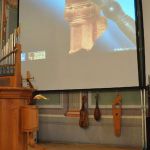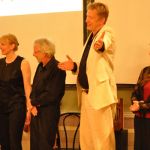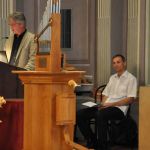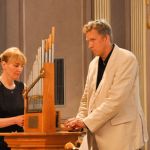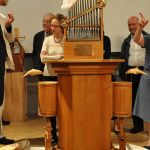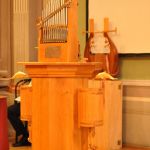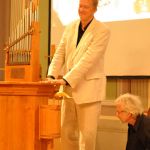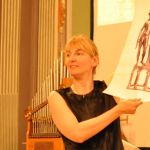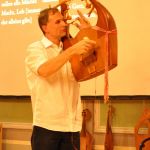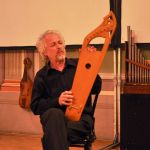
Music in the Stone Age
XV Symposium of the ICTM Study Group on Music Archaeology & Workshop of the European Music Archaeology Project (EMAP)
August 24th-27th, 2017 - Venue: Research Centre of the Slovenian Academy of Sciences and Arts, Ljubljana (Slovenia)
XV Symposium of the ICTM Study Group on Music Archaeology & Workshop of the European Music Archaeology Project (EMAP)
August 24th-27th, 2017 - Venue: Research Centre of the Slovenian Academy of Sciences and Arts, Ljubljana (Slovenia)

The XV Symposium of the ICTM Study Group on Music Archaeology will be held in Ljubljana, Slovenia, from August 24-27, 2017. The symposium is intended to establish a platform of current research on topics such as prehistoric human music cultures and their respective sound tools, or the archaeoacoustics of caves and other prehistoric sites. Besides reflecting current projects and results, it is intended to deepen ongoing discussions, and to publish the information in an anthology.
Possible sessions of the symposium are the making, playing, and meaning of bird bone pipes or any other sound artefacts believed to be Palaeolithic, Mesolithic and Neolithic musical instruments, the evolution of human neurobiology in relation to sound production/music-making, the archaeoacoustics of prehistoric sites, or organological developments and cultural interactions in the earliest phase of human music.
During the symposium, a panel and round table funded by the European Music Archaeology Project will be held. The event is intended to reconsider divergent views on the perforated thighbone of a cave bear excavated in the Divje babe I cave, Slovenia, which lead to the heated controversy if this object could be a flute produced in the time of the Neanderthals. The find stimulated research over the last two decades, and the debate is still going on in the light of latest laboratorial results. On the workshop and round table both pro- and counter-arguments will be addressed and openly discussed.
During the symposium a visit to the Archaeomusica exhibition, shown during the summer of 2017 in the National Museum of Slovenia, will be organised.

The III Jornadas de Música Antigua of the University of Valladolid, organized by the Department of Musicology of the University of Valladolid and the EMAP will take place in Valladolid from the 15th to the 29th April. They aim to create an space for learning and discussion around early music, especially between the 15th and 17th Century. Together with several conferences by top scholars, there will be a Seminar and a Concert by the Swedish Music Archaeologists Cajsa S. Lund and the early music Swedish group Ensemble Mare Balticum, around the musical instruments recovered from the Kronan shipwreck and the repertoire of 17th Century Sweden, in an event that shows the fruitful collaboration within EMAP of Musik i Syd and the University of Valladolid.
Seminar
Música a bordo del Kronan, buque insignia de la Armada Real Sueca (1676)
Cajsa S. Lund & Ensemble Mare Balticum, Sweden
Tuesday 26th April
Aula Magna Lope de Rueda (Facultad de Filosofía y Letras)
11:00 to 13:00h
Concert
Música a bordo del Kronan, buque insignia de la Armada Real Sueca (1676)
Ensemble Mare Balticum
Tuesday 26th April
Paraninfo Facultad de Derecho, 19:30h
Participants can make the free inscriptions at:
This email address is being protected from spambots. You need JavaScript enabled to view it. and This email address is being protected from spambots. You need JavaScript enabled to view it.
Música a bordo del Kronan, buque insignia de la Armada Real Sueca (1676)
Ensemble Mare Balticum
Tuesday 26th April
Paraninfo Facultad de Derecho, 19:30h
Participants can make the free inscriptions at:
This email address is being protected from spambots. You need JavaScript enabled to view it. and This email address is being protected from spambots. You need JavaScript enabled to view it.
A certificate of participation of 35 hours will be given to those inscribed.
![]() Download Kronan poster (Spanish)
Download Kronan poster (Spanish)
![]() Download Kronan program (Spanish)
Download Kronan program (Spanish)
Brass Instruments from Ancient Europe
Viterbo, November 11th – 13th, 2015 – Venue: Aula Magna del complesso storico di S. Maria in Gradi – Università degli Studi della Tuscia
Viterbo, November 11th – 13th, 2015 – Venue: Aula Magna del complesso storico di S. Maria in Gradi – Università degli Studi della Tuscia

Brass instruments play an important part in EMAP, partly because so many have survived to tell of their past and partly because they played such an important role in both the ritual and artistic life of the past.
Over the first half of the five-year project, the Ancient Brass Team has examined, measured, analysed, reconstructed and learnt to play instruments which disappeared from use over the past few millennia. EMAP has benefitted from the vast amount of knowledge which experts from all over Europe have brought to bear on the task of recreating the exciting, entertaining and exhilarating instruments which take us back into lost cultures, to experience the sights and sounds of their worlds.
The EMAP team has chosen instruments to represent as wide a range of European cultures as possible, while not neglecting the immediate neighbours who have influenced European ideas over the millennia.
Pre-metal age instruments speak from the distant past with the conch shell trumpets representing long-surviving traditions which worshipped and utilised natural materials in a way we have lost. Ethnographic examples, made from these natural materials can help to revive this voice and are used to give it a part in the proceedings.
The early development of metal instruments is reflected in the two great European brass traditions from the Northern European Bronze Age, the Irish Horns and the Scandinavian and Baltic Lurs. Neither of these traditions was static in the past and this is reflected in the presence in EMAP of the earliest of the lurs and 19th Century reproductions of later, more elaborate instruments which are much more recognisable as the iconic lur.
In the Greek world, the salpinx was to be found embedded in many expressions of their culture, as is reported in the huge number of references in Ancient Greek literature. The instrument is represented in EMAP both from the centre and from the periphery of the Greek world.
The Etruscans, whom the Ancient Greeks regarded as masters in metalworking bring their influence to bear with early metal horns and their own invention, the lituus, which appears in its early form to span different traditions in metalworking. From later Etruscan times, the litui and cornua join voices to herald a new development in the world of brass and the Etruscan iconography shows this ensemble in use, also as a symbol of high rank.
Over the first half of the five-year project, the Ancient Brass Team has examined, measured, analysed, reconstructed and learnt to play instruments which disappeared from use over the past few millennia. EMAP has benefitted from the vast amount of knowledge which experts from all over Europe have brought to bear on the task of recreating the exciting, entertaining and exhilarating instruments which take us back into lost cultures, to experience the sights and sounds of their worlds.
The EMAP team has chosen instruments to represent as wide a range of European cultures as possible, while not neglecting the immediate neighbours who have influenced European ideas over the millennia.
Pre-metal age instruments speak from the distant past with the conch shell trumpets representing long-surviving traditions which worshipped and utilised natural materials in a way we have lost. Ethnographic examples, made from these natural materials can help to revive this voice and are used to give it a part in the proceedings.
The early development of metal instruments is reflected in the two great European brass traditions from the Northern European Bronze Age, the Irish Horns and the Scandinavian and Baltic Lurs. Neither of these traditions was static in the past and this is reflected in the presence in EMAP of the earliest of the lurs and 19th Century reproductions of later, more elaborate instruments which are much more recognisable as the iconic lur.
In the Greek world, the salpinx was to be found embedded in many expressions of their culture, as is reported in the huge number of references in Ancient Greek literature. The instrument is represented in EMAP both from the centre and from the periphery of the Greek world.
The Etruscans, whom the Ancient Greeks regarded as masters in metalworking bring their influence to bear with early metal horns and their own invention, the lituus, which appears in its early form to span different traditions in metalworking. From later Etruscan times, the litui and cornua join voices to herald a new development in the world of brass and the Etruscan iconography shows this ensemble in use, also as a symbol of high rank.
While the Romans developed their Etruscan brass heritage, they never failed to acknowledge the legacy from their northern neighbour in their literature but the physical heritage is courtesy of Vesuvius. The four cornua from Pompeii are represented both in vision and voice and will be accompanied, as in the iconography, by a sibling instrument, the tuba.
Iron-Age Europe produced little in the way of literature to trumpet their achievements but their instruments do it for them better than any words could. The massive long-curved horns, from the UK and France will make their presence felt in sight and sound.
However, the quintessential native European brass instrument, the carnyx, holds it head high. From the fascinating iconography of the Gundestrup cauldron and the coins and statuary which depict this, to the earliest find, in the English Midlands and onto the latest, most-spectacular find from Tintignac in France, side by side with the revealing fragments from Sanzeno in Italy, the carnyx will be both seen and heard.
Iron-Age Europe produced little in the way of literature to trumpet their achievements but their instruments do it for them better than any words could. The massive long-curved horns, from the UK and France will make their presence felt in sight and sound.
However, the quintessential native European brass instrument, the carnyx, holds it head high. From the fascinating iconography of the Gundestrup cauldron and the coins and statuary which depict this, to the earliest find, in the English Midlands and onto the latest, most-spectacular find from Tintignac in France, side by side with the revealing fragments from Sanzeno in Italy, the carnyx will be both seen and heard.
Not all metal-age ‘brass’ instruments were of bronze, however, and EMAP will celebrate also the beautiful Celt-Iberian recreations of ceramic brass from the Iberian Peninsula. Frequently overlooked, these instruments speak of a local tradition which was both rich and inventive.
The 2015 EMAP Conference in Viterbo will gather together all these instruments to celebrate their past, bringing with them researchers, makers and players to join together in the task of reawakening the spirits of the ancient world.
Joining the European team at this conference will be the Historic Brass Society, in a unique experiment to mix the pre-historic with the historic, creating a collective powerhouse of knowledge and experience which will bring new interpretive skills to test ideas about the ancient world of brass instruments in an exciting collaboration.
Scientific committee:
Peter Holmes (Chairman)
Paolo Bellintani, Murray Campbell, Stefano De Angeli, Gian Maria Di Nocera,
Emiliano Li Castro, Christophe Maniquet, Marina Micozzi, Claudia Pelosi.
Paolo Bellintani, Murray Campbell, Stefano De Angeli, Gian Maria Di Nocera,
Emiliano Li Castro, Christophe Maniquet, Marina Micozzi, Claudia Pelosi.

First reconstruction of the Etruscan lituus from Tarquinia, made by Peter Holmes. Photographer: Placido Scardina - click here to listen to the audio files
Aula Magna and Auditorium of the historical complex of S. Maria in Gradi, Viterbo (Italy),
November 12th, 2015: conference and experimental playing performed by members of the Ancient Brass Team (Peter Holmes, Ivano Ascari, John Kenny, Patrick Kenny, Gaetano Delfini).
Photographer: Francesco Marano
Brass Instruments from Ancient Europe: the concert
Viterbo, November 14th, 2015, 21:00 – Venue: Auditorium del complesso storico di S. Maria in Gradi – Università degli Studi della Tuscia
Musicians: Ivano Ascari, Gaetano Delfini, Daniele Ercoli, John Kenny, Patrick Kenny, Alberto Morelli.
VISTA
Visual Interactive and Sound Technology in Archaeology
Tuesday 16th June 2015, 10am - 5pm - Venue: Sir George Buckley Lecture Theatre, CSLG01, University of Huddersfield, Huddersfield, West Yorkshire, UK, HD1 3DH.
Visual Interactive and Sound Technology in Archaeology
Tuesday 16th June 2015, 10am - 5pm - Venue: Sir George Buckley Lecture Theatre, CSLG01, University of Huddersfield, Huddersfield, West Yorkshire, UK, HD1 3DH.

This symposium collects together researchers working in digital modelling and reconstruction, app development, acoustic modelling,
interactive design, audio-visual applications, and multimedia, and their relationships to archaeology, heritage science, cultural industries
and museums.
European Music Archaeology Project and British Audio-Visual Research Network
European Music Archaeology Project and British Audio-Visual Research Network
Música e identidad en el Mediterráneo
Mujeres, Ritos y Trance desde la antigüedad al presente
March 4th - 6th, 2015 - Venue: Facultad de Filosofía y Letras - Universidad de Valladolid
March 4th - 6th, 2015 - Venue: Facultad de Filosofía y Letras - Universidad de Valladolid

Seminar on female music and identities in the Mediterranean from the antiquity to the present.
This event has been organized by the EMAP, the Music Archaeology Study Group of the Spanish Musicological Society, the DRUM Marie Curie Research project and the Aula de Música of the University of Valladolid. 

![]() Download documentary poster (Spanish)
Download documentary poster (Spanish)
![]() Download concert poster (Spanish)
Download concert poster (Spanish)
Download seminar program (Spanish)![]()
Klang – Objekt – Kultur – Geschichte
Sound – Object – Culture – History
9th Symposium of the International Study Group on Music Archaeology
Tuesday, 9th – Friday, 12th September 2014 - Venue: Ethnologisches Museum, Lansstraße 8, 14195 Berlin, Germany
9th Symposium of the International Study Group on Music Archaeology
Tuesday, 9th – Friday, 12th September 2014 - Venue: Ethnologisches Museum, Lansstraße 8, 14195 Berlin, Germany
Sound plays a central role in all cultures, whether in a ritual context, as a signal when hunting or during wartime, as pure entertainment, or when associated with some kind of performative activity. Most sounds relate to some objects. These can be the tools used to generate acoustic phenomena such as musical instruments, everyday objects reinterpreted in a new context to produce sound, or natural phenomena or the human body as part of a communicative, performative act. The interrelationships of sound, sounds, object and objects always arise in a social context, which is an integral component of culture and thus reveals culture. All this takes place in historical dimensions, and so in a broader sense a history of culture comes into being, and indeed a cultural history dealing with objects and their auditory quality, with sound objects. This means that a multitude of associations can relate the four concepts in our title, because we are investigating sound objects as well as cultural history, object culture as well as sound history, and sound culture as well as object history.

On Wednesday 10th, the 4-day conference presented a panel dedicated to some of the researches undertaken by the Team of the European Music Archaeology Project: “Europe’s archaeological music cultures and their integration”.
Meeting on the Ancient Hydraulis
Tuesday 20th - Wednesday 21st May 2014. Venue: Library of the Institute for the Study of Ancient Culture of the Austrian Academy of Sciences, Bäckerstraße 13, 1010 Wien, Austria

On May 20/21, a dozen music archaeologists came together at the Austrian Academy of Sciences to discuss recent developments concerning our knowledge of the ancient organ, both in terms of its manufacture and musical potential and in view of its historical contexts and development. Two reconstructions were presented: the latest one (by S. Rühling and M. Zierenberg) reproducing the instrument proper in authentic materials, the other (by J. Willberg) constructed as a true water-organ according to ancient descriptions.
On the first evening, some of the participants united for a public concert, performing vocal and instrumental music from Classical Antiquity and the Middle Ages on replicas and reconstructions of period instruments.
On the first evening, some of the participants united for a public concert, performing vocal and instrumental music from Classical Antiquity and the Middle Ages on replicas and reconstructions of period instruments.



















